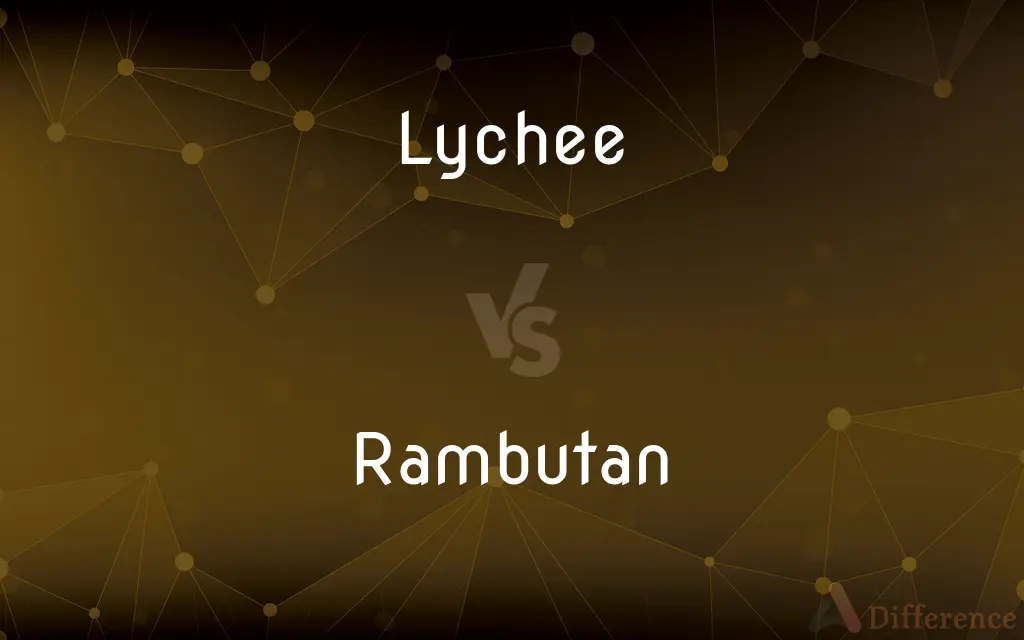Lychee vs. Rambutan — What's the Difference?
Edited by Tayyaba Rehman — By Fiza Rafique — Updated on October 30, 2023
Lychee is a small, smooth-skinned fruit with translucent flesh, while rambutan is a similar-sized fruit but with hairy, spiky skin.

Difference Between Lychee and Rambutan
Table of Contents
ADVERTISEMENT
Key Differences
The lychee is a fruit native to China and has been cultivated there for over 2,000 years. It has a rough, reddish skin and is roughly the size of a golf ball. On the inside, its juicy, translucent flesh surrounds a single, large seed. The taste of the lychee is sweet and aromatic. The rambutan, on the other hand, originates from Southeast Asia. It is visually distinctive due to its hairy, spiky skin, which is usually red or yellow. The flesh inside is similar to that of the lychee, being juicy and sweet, but its seed is more oblong.
Both lychee and rambutan belong to the soapberry family, making them close relatives. While they have similar juicy and translucent flesh, their external appearances are vastly different. The lychee's skin is smooth and tough, whereas the rambutan's skin is covered in soft spines or hairs, giving it an almost hairy appearance.
It's important to note that while lychee and rambutan may appear similar in some aspects, especially the taste and texture of their flesh, they are distinct fruits. The lychee, often found in drinks, desserts, and various dishes, offers a unique flavor that can be both sweet and tart. Conversely, the rambutan, although less commonly found in Western cuisine, is gaining popularity and is usually eaten fresh.
In terms of nutritional value, both lychee and rambutan offer numerous health benefits. They are rich in vitamin C, potassium, and antioxidants. However, while the lychee has a higher sugar content, the rambutan provides more fiber. So, both fruits, although similar in many aspects, have their own distinctive features and nutritional benefits.
Comparison Chart
Origin
China
Southeast Asia
ADVERTISEMENT
Skin Appearance
Rough, reddish, and smooth
Hairy, spiky, usually red or yellow
Taste
Sweet and aromatic
Sweet
Common Uses
Drinks, desserts, dishes
Eaten fresh
Nutritional Difference
Higher sugar content
Provides more fiber
Compare with Definitions
Lychee
Sweet and aromatic in taste.
The lychee sorbet had a delightful sweet and aromatic flavor.
Rambutan
Close relative to the lychee in the soapberry family.
Rambutan and lychee are both members of the soapberry family, explaining their similar taste.
Lychee
Often used in drinks and desserts.
Lychee martinis have become quite popular in upscale bars.
Rambutan
Typically eaten fresh.
He peeled the rambutan skin and enjoyed the fruit fresh.
Lychee
A fruit native to China with translucent flesh.
She added fresh lychee to her fruit salad for a sweet touch.
Rambutan
Southeast Asian fruit with a hairy exterior.
She was curious to try the rambutan she saw at the exotic fruit stand.
Lychee
Member of the soapberry family.
Lychee, like its cousin rambutan, belongs to the soapberry family.
Rambutan
Flesh similar to lychee but usually encasing an oblong seed.
The juicy rambutan flesh reminded him of lychee.
Lychee
Small fruit with a rough, reddish skin.
Lychee's unique appearance makes it stand out in the market.
Rambutan
Small fruit with spiky, soft hairs.
Rambutan's unique hairy appearance intrigued many first-time buyers.
Lychee
Lychee (US: LEE-chee; UK: LIE-chee; Litchi chinensis; Chinese: 荔枝; pinyin: lìzhī; Jyutping: lai6 zi1; Pe̍h-ōe-jī: nāi-chi) is the sole member of the genus Litchi in the soapberry family, Sapindaceae. It is a tropical tree native to the Guangdong and Fujian provinces of southeastern China, where cultivation is documented from the 11th century.
Rambutan
Rambutan (; taxonomic name: Nephelium lappaceum) is a medium-sized tropical tree in the family Sapindaceae. The name also refers to the edible fruit produced by this tree.
Lychee
An evergreen tree (Litchi chinensis) native to China, cultivated for its bright red fruits with sweet white pulp surrounding a large seed.
Rambutan
A tree (Nephelium lappaceum) of Southeast Asia, bearing edible oval red fruit with soft spines.
Lychee
The fruit of this tree.
Rambutan
The fruit of this tree, having juicy white flesh surrounding a single seed.
Lychee
The dried fruit of this tree. Also called lychee nut.
Rambutan
A tree, Nephelium lappaceum, of Southeast Asia.
Lychee
The Chinese tropical fruit tree Litchi chinensis, of the soapberry family.
Rambutan
The fruit of this tree.
Lychee
That tree's bright red oval fruit with a single stone surrounded by a fleshy white aril.
Rambutan
A Malayan fruit produced by the tree Nephelium lappaceum, and closely related to the litchi nut. It is bright red, oval in shape, covered with coarse hairs (whence the name), and contains a pleasant acid pulp. Called also ramboostan.
Lychee
A soft pink-red colour, like that of a lychee rind (also called lychee red).
Rambutan
Malayan tree bearing spiny red fruit
Lychee
See Litchi.
Rambutan
Pleasantly acid bright red oval Malayan fruit covered with soft spines
Lychee
Chinese fruit having a thin brittle shell enclosing a sweet jellylike pulp and a single seed; often dried
Common Curiosities
Are lychee and rambutan from the same family?
Yes, both fruits belong to the soapberry family.
What is a lychee?
Lychee is a small fruit with a rough, reddish skin and sweet, translucent flesh, native to China.
How does rambutan look?
Rambutan has a hairy, spiky skin, usually red or yellow in color, and is native to Southeast Asia.
Can I substitute lychee for rambutan in recipes?
Yes, lychee and rambutan have similar tastes and textures, but there might be subtle differences in the final dish.
Can I drink alcohol with lychee?
Yes, lychee is often used in cocktails, like the popular lychee martini.
Which is sweeter, lychee or rambutan?
While both are sweet, lychee tends to have a slightly more aromatic and tart flavor.
How do you eat rambutan?
Rambutan is typically peeled and eaten fresh, discarding the seed inside.
Are there any health benefits to eating these fruits?
Both lychee and rambutan are rich in vitamin C, potassium, and antioxidants.
Why does rambutan have a hairy skin?
The hairy appearance is natural and is one of the distinguishing features of the rambutan fruit.
Where can I find lychee in the grocery store?
Lychee can often be found in the exotic or tropical fruit section of larger grocery stores or specialty markets.
Can you eat the skin of the lychee?
No, the skin of the lychee is tough and should be peeled before eating.
Is there a seed inside the lychee?
Yes, lychee has a single, large seed inside which should not be eaten.
How can I tell if a rambutan is ripe?
A ripe rambutan will have a bright red or yellow skin, and the flesh will be juicy and sweet.
How is rambutan different from lychee in terms of nutrition?
While both are nutritious, lychee has a higher sugar content, and rambutan provides more fiber.
Are lychee and rambutan seasonal fruits?
Yes, both fruits have specific seasons, but availability might vary based on location and imports.
Share Your Discovery

Previous Comparison
Tug vs. Pull
Next Comparison
Metre vs. YardAuthor Spotlight
Written by
Fiza RafiqueFiza Rafique is a skilled content writer at AskDifference.com, where she meticulously refines and enhances written pieces. Drawing from her vast editorial expertise, Fiza ensures clarity, accuracy, and precision in every article. Passionate about language, she continually seeks to elevate the quality of content for readers worldwide.
Edited by
Tayyaba RehmanTayyaba Rehman is a distinguished writer, currently serving as a primary contributor to askdifference.com. As a researcher in semantics and etymology, Tayyaba's passion for the complexity of languages and their distinctions has found a perfect home on the platform. Tayyaba delves into the intricacies of language, distinguishing between commonly confused words and phrases, thereby providing clarity for readers worldwide.















































